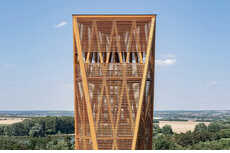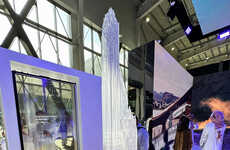Mjøstårnet is Set to be the World's Tallest Timber Structure
Joey Haar — February 15, 2018 — Art & Design
Modern skyscrapers were enabled by developments in the production of steel around the turn of the 20th century, and new engineering techniques have allowed for truly vertiginous glass and steel edifices, but Mjøstårnet is a planned skyscraper that abandons those materials. The building, which has currently begun construction in Brumundal, Norway, is made primarily from timber, and it is slated to stand 81 meters high, making it by far the tallest timber structure in the world.
At the planned height for Mjøstårnet, the building will be significantly taller than the next closest competitor. Treet, a tower in Bergen, is the current record-holder, and it stands 51 meters.
Brumundal's record-breaking building will rise 18 storeys, and it will be occupied with apartments, a hotel, a restaurant, offices, and even a 4,700-square-meter swimming hall.
Image Credit: Moelven
At the planned height for Mjøstårnet, the building will be significantly taller than the next closest competitor. Treet, a tower in Bergen, is the current record-holder, and it stands 51 meters.
Brumundal's record-breaking building will rise 18 storeys, and it will be occupied with apartments, a hotel, a restaurant, offices, and even a 4,700-square-meter swimming hall.
Image Credit: Moelven
Trend Themes
1. Timber Skyscrapers - The use of timber in skyscraper construction creates opportunities for eco-friendly and sustainable building practices that challenge traditional steel and concrete structures.
2. Vertical Timber Construction - Developing new engineering techniques for vertically maximizing timber structures for the construction of super-tall buildings provides disruptive innovation opportunities.
3. Timber Mixed-use Buildings - Adapting timber for mixed-use building structures, such as incorporating offices, restaurants, or swimming halls, provides innovative sustainability solutions beyond residential towers.
Industry Implications
1. Architecture - Architects have an opportunity to leverage sustainable timber structures as a viable alternative to traditional steel and concrete by creating eco-friendly and resource-efficient building designs.
2. Construction - The construction industry can find new ways to develop and work with timber to create strong, safe, and sustainable structures that can help reduce the environmental footprint of buildings.
3. Real Estate - The real estate industry can explore the benefits of timber buildings as a selling point for environmentally conscious buyers, promoting eco-friendly and sustainable residential and commercial properties.
0.4
Score
Popularity
Activity
Freshness














